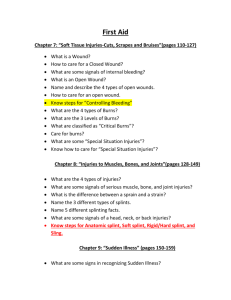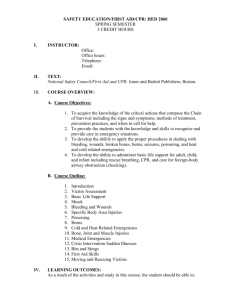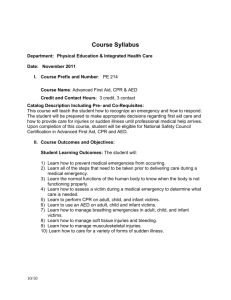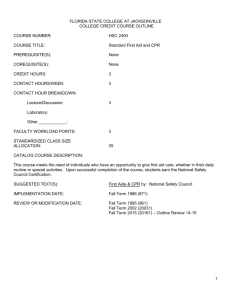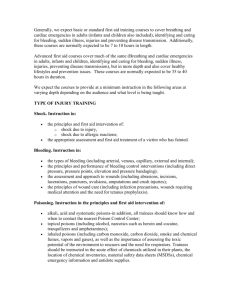QUEENSBOROUGH COMMUNITY COLLEGE
advertisement
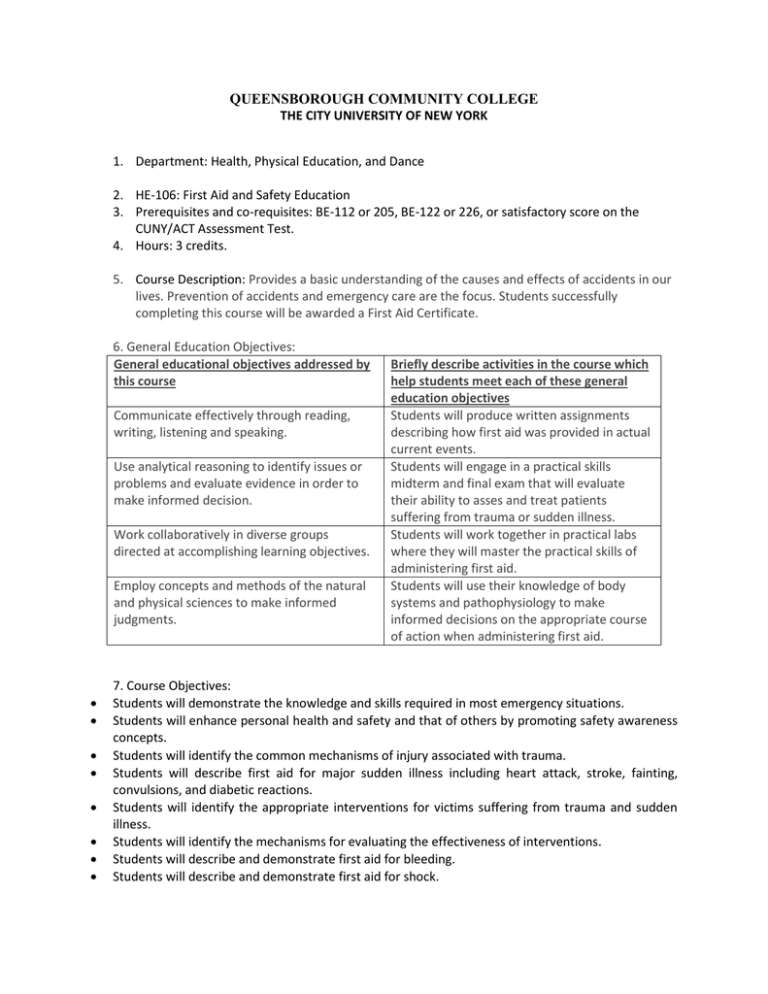
QUEENSBOROUGH COMMUNITY COLLEGE THE CITY UNIVERSITY OF NEW YORK 1. Department: Health, Physical Education, and Dance 2. HE-106: First Aid and Safety Education 3. Prerequisites and co-requisites: BE-112 or 205, BE-122 or 226, or satisfactory score on the CUNY/ACT Assessment Test. 4. Hours: 3 credits. 5. Course Description: Provides a basic understanding of the causes and effects of accidents in our lives. Prevention of accidents and emergency care are the focus. Students successfully completing this course will be awarded a First Aid Certificate. 6. General Education Objectives: General educational objectives addressed by this course Communicate effectively through reading, writing, listening and speaking. Use analytical reasoning to identify issues or problems and evaluate evidence in order to make informed decision. Work collaboratively in diverse groups directed at accomplishing learning objectives. Employ concepts and methods of the natural and physical sciences to make informed judgments. Briefly describe activities in the course which help students meet each of these general education objectives Students will produce written assignments describing how first aid was provided in actual current events. Students will engage in a practical skills midterm and final exam that will evaluate their ability to asses and treat patients suffering from trauma or sudden illness. Students will work together in practical labs where they will master the practical skills of administering first aid. Students will use their knowledge of body systems and pathophysiology to make informed decisions on the appropriate course of action when administering first aid. 7. Course Objectives: Students will demonstrate the knowledge and skills required in most emergency situations. Students will enhance personal health and safety and that of others by promoting safety awareness concepts. Students will identify the common mechanisms of injury associated with trauma. Students will describe first aid for major sudden illness including heart attack, stroke, fainting, convulsions, and diabetic reactions. Students will identify the appropriate interventions for victims suffering from trauma and sudden illness. Students will identify the mechanisms for evaluating the effectiveness of interventions. Students will describe and demonstrate first aid for bleeding. Students will describe and demonstrate first aid for shock. Students will describe first aid for poisoning. Students will describe and demonstrate first aid for burns. Students will describe first aid for heat exposure. Students will describe first aid for cold exposure. Students will describe and demonstrate first aid for bone and joint injuries. Students will describe and demonstrate first aid for specific injuries to the eyes, head, nose, ears, chest, and abdomen. Students will correctly identify necessary supplies to fill a standard first aid kit. Student Learning Outcomes Students will demonstrate the knowledge and skills required in most emergency situations. Students will enhance personal health and safety and that of others by promoting safety awareness concepts. Students will describe first aid for major sudden illness including heart attack, stroke, fainting, convulsions, and diabetic reactions. Students will identify the appropriate interventions for victims suffering from trauma and sudden illness. Students will describe and demonstrate first aid for bleeding. Students will describe and demonstrate first aid for shock. Students will describe first aid for poisoning. A. Students will describe the importance of EMS systems, the roles and responsibilities of the first responder. B. Students will describe factors that may affect decisions on deciding to help. A. Students will identify modifiable risk factors for different illnesses and injuries. B. Students will identify primary, secondary, and tertiary injury prevention programs. A. Students will demonstrate proficiency in resuscitation techniques like CPR. A. Students will use information gathered from knowledge of pathophysiology, their patient assessment to describe the management of several different types of medical emergencies. A. Students will describe the differences between arterial, capillary, and venous bleeding. B. Students will demonstrate how to apply a pressure bandage to a mock patient. A. Students will compare and contrast the different types of shock. B. Students will demonstrate how to care for hypovolemic, cardiogenic, psychogenic, and neurogenic shock on a mock patient. A. Students will describe how different poisons enter the body and how to safely intervene at the scene of an apparent poisoning. Students will describe and demonstrate first aid for burns. Students will describe and demonstrate first aid for bone and joint injuries. Students will correctly identify necessary supplies to fill a standard first aid kit. B. Students will identify measures that can be taken to prevent poisoning. C. Students will identify poison control labeling on various household items. A. Students will be able to describe the difference between 1st, second, and 3rd degree burns. B. Students will demonstrate how to care for a burn victim of varying intensities. A. Students will describe the different types of fractures and dislocations and describe appropriate interventions. B. Students will demonstrate how to splint long bone injuries and immobilize joint dislocations on a mock patient. A. Students will make a list of items that should be included in a household or workplace first aid kit. 8. Topics covered: Legal considerations, patient assessment, CPR, cardiac emergencies, breathing emergencies, poisoning, environmental emergencies, sudden illness, musculoskeletal injuries, bleeding, shock, burns, spinal injuries, and trauma. 9: Required Reading: First Aid, CPR and AED Advanced Publication Date: March 29, 2011 | ISBN-10: 1449635059 | ISBN-13: 978-1449635053 | Edition: 6 10: Methods of Evaluation: Students will be evaluated by class participation, practical skills examinations, midterm and final written examinations. 11. Recommended Attire: This class is very practical in nature and requires physical work so students should dress in appropriate comfortable clothing. 13. Academic Integrity Policy: According to the College’s Academic Integrity policy, you must avoid plagiarism, fabrication, cheating, and all forms of academic misconduct. For more information, consult the College Catalog, as well as this document: http://web.cuny.edu/academics/infocentral/policies/academic-integrity.pdf Typical consequences for some Academic Integrity violations: •First offense: A grade of 0% on the assignment. This grade cannot be dropped. •Second offense: An F in the class and the filing of a report with the Office of Student Affairs. 14. Accommodations for Disabilities: Any student who feels that he/she may need an accommodation based upon the impact of a disability should contact me privately to discuss your specific needs. Please contact the office of Services for Students with Disabilities in Science Building, room 132 (718-631-6257) to coordinate reasonable accommodations for documented disabilities.
